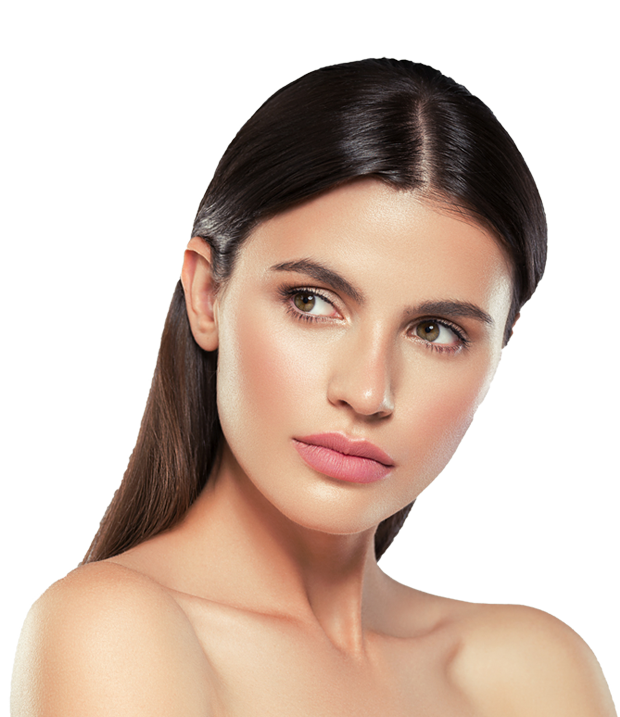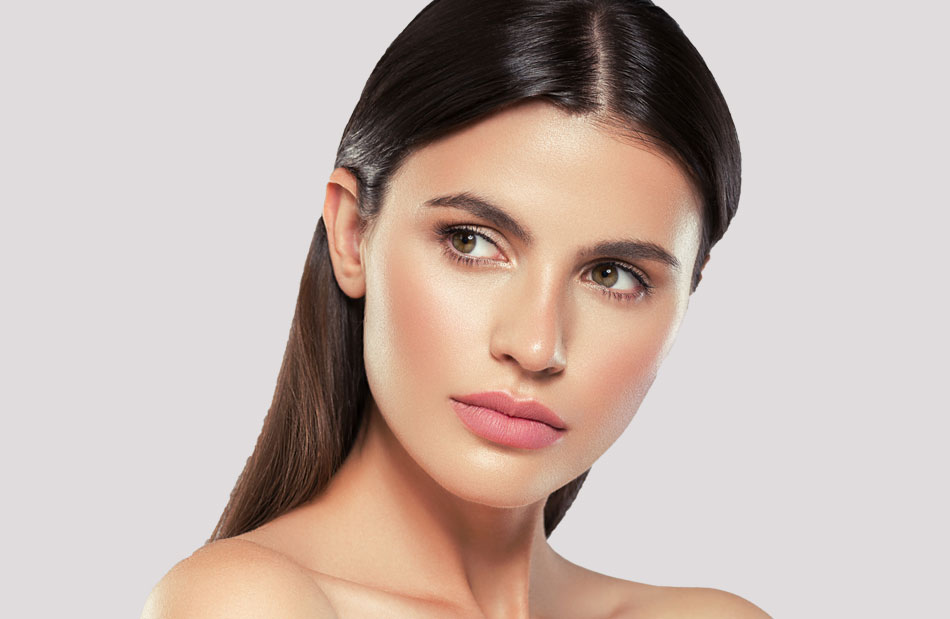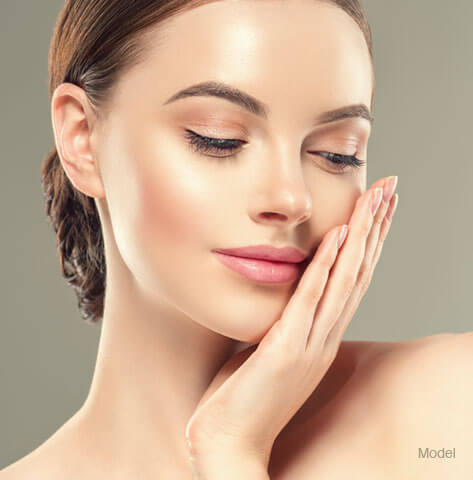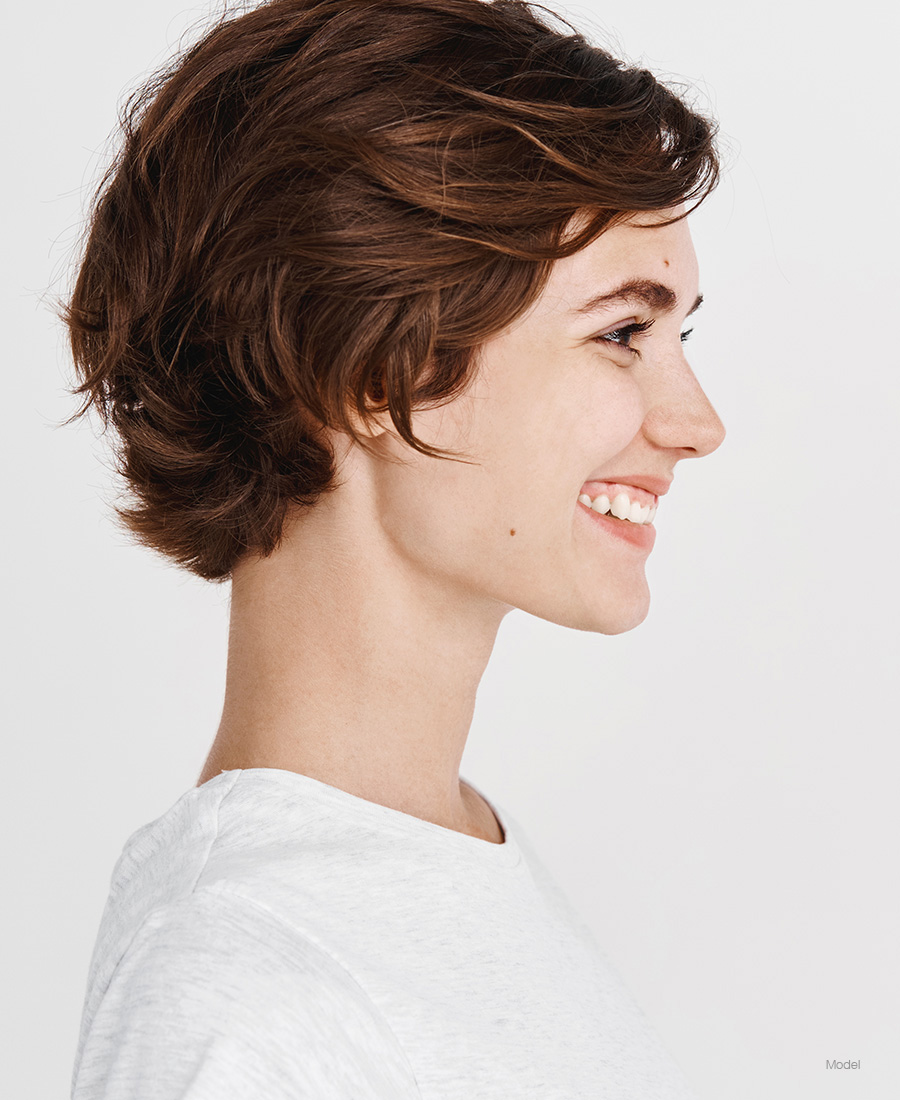

Rhinoplasty
in Austin, TX
Confidence – Love the Mirror
Positioned between the eyes and the mouth, the nose is the aesthetic bulls-eye of the face. Because of its central location, both its size and shape can have a significant influence on the perceived appearance of the eyes, eyebrows, lips, and chin, as well as overall facial harmony. Rhinoplasty is a surgical procedure performed to bring the appearance of the nose into an aesthetically pleasing, harmonious balance with the rest of your face.
Introduction to Rhinoplasty
Besides being the focal center of your face, the nose has an essential role in a process vital to human life—breathing. Thus, the nose holds considerable functional significance in addition to its aesthetic value. It is also the case that aesthetic concerns (cosmetic flaws) and functional problems (breathing difficulties) are inextricably interrelated.
For this reason, aesthetic nasal surgery, known as rhinoplasty or cosmetic rhinoplasty, is often performed at the same time as functional nasal surgeries such as septoplasty (to correct a deviated septum), nasal vestibular stenosis correction, and inferior turbinate reduction (to address nasal obstructions). While rhinoplasty is done to improve shape and size, and septoplasty and correction of nasal vestibular stenosis are employed to clear nasal passages and maximize breathing, these procedures can be synergistic with regard to their effect on appearance as well as function. Dr. Adam Bryce Weinfeld, a board-certified plastic surgeon with expertise in this particular procedure, goes beyond the standard to achieve excellence in every rhinoplasty he performs.

Reasons to Consider Rhinoplasty
When a face is observed, the gaze is focused on the eyes and mouth, shifting from one to the other. The explanation for this is that faces are observed for the purpose of communication. Eyes communicate non-verbal information, and the mouth verbal information. Even though the nose holds a prominent position in the middle of the face, between the two features of communication, it is not natural for significant visual gaze to be focused on it. However, if a nose has an unusual or unbalanced shape, or it is too large or too small, it draws attention away from the two features of communication and is then perceived as unattractive. An attractive nose does not draw much attention.
There are first-tier (major) and second-tier (minor) abnormalities of the nose. Both draw negative attention. Aesthetic abnormalities that fall into the first tier include: unbalanced size, dorsal shape, tip shape, alar shape, nostril shape, columellar shape, and nasal deviation. The complex structure of the nose opens the door for a myriad of other minor irregularities that round out the second tier. In the interest of clarity and simplicity, I will delve into the first tier only as the features that comprise it account for 90% of the aesthetic concerns that drive the desire to undergo surgical rhinoplasty.
The characterization of size abnormalities is binary: either too small or too large. Both of these size irregularities can be corrected with rhinoplasty. Most people are interested in a reduction in the size of their nose or parts of their nose. Nonetheless, some people, fewer in number, have noses that are too small for their face or have portions of their nose that are diminutive and thus desire augmentation rhinoplasty (a rhinoplasty technique that adds cartilage to the structure in a strategic and precise fashion to make the nose bigger).
The most common deformity of the dorsal contour of the nose is a hump or bump; plastic surgeons refer to this as a dorsal convexity. The revision desired by people with this shape is the removal of the nasal hump in favor of a straight contour along the “bridge” of the nose from the nasal take off between the eyes to the tip. The importance and complexity of this is often overlooked. I prefer to perform this maneuver in a composite separation and incremental reduction technique, followed by the use of spreader grafts or spreader flaps, to avoid long-term inverted-V deformities and/or a scooped-out appearance.
The two most common tip shape forms that people want revised are a boxy or a bulbous tip. Calculated modifications of tip width and shape are performed to affect a positive change in these two tip types. The goal for women is often to make the nose more refined and delicate, and for men, it is to make the tip more distinguished. Tip projection (how far the tip extends from the base of the nose) and tip rotation (the angle at which the tip and the columella beneath it connect with the upper lip) are two additional characteristics that often require adjustment in precision rhinoplasty.
The final, and perhaps the most important, first-tier aesthetic problem that is addressed in any premium rhinoplasty is crookedness. Crookedness is a deviation from the midline or a lack of straightness. People often say that their nose bends to one side of their face in a way that detracts from the overall appearance of both the nose and the face. Prior trauma, such as a broken nose, is sometimes an antecedent cause of this deformity, and sometimes crookedness is congenital/developmental in origin. Independent of etiology, crookedness often relates to abnormalities of the nasal septum and/or bone. As these elements are the structural core of the nose, correcting their form is paramount to improving shape.
It is extremely rare that the aesthetic abnormalities discussed above occur in isolation from one another. Due to the aesthetic, functional, and structural integration of the features, nose deformities occur in interrelated clusters. For that reason, precision rhinoplasty is designed and employed to address the composite aesthetic issues in a synergistic fashion. In my experience, it is relatively rare for someone to need a nasal hump reduction or tip rhinoplasty alone. While these “minimalist” techniques might seem attractive and may have marketing value, my personal perspective is that they can sometimes leave the nose internally imbalanced. That is to say, I believe procedures such as a “tip rhinoplasty” often create an operated look because they don’t modify the nose harmoniously. Precise interconnected changes throughout often lead to a more natural rhinoplasty. It is rare in life that a comprehensive but subtle approach is not the best approach to a problem.
Solution
Rhinoplasty is a surgical procedure of the nose that is designed to reshape and/or resize the nose by precisely modifying its structure to bring about a more desirable appearance.
Rhinoplasty surgery is commonly referred to as a “nose job,” however, I cringe at the utterance of that term. Please do not mistake my objection to this nickname for arrogance. That is not the case; instead, my opposition to the term “nose job” stems from my belief that the term utterly fails to capture and convey the importance and complexity of a high-quality rhinoplasty. Plastic surgeons agree that rhinoplasty is one of the most complex cosmetic procedures performed. Think of it in these terms: referring to a Maserati or an Aston Martin as “wheels” fails to capture the elegance of the design and the complexity of the engineering of these vehicles.
Rhinoplasty is a procedure where success is measured in millimeters and minute angles. Furthermore, there is a very subtle but very definite line that segregates success from regret and natural appearance from a “done” look. Yet rhinoplasty is a very common procedure, consistently topping the lists of the most frequent procedures requested by both men and women. The combination of frequency and complexity is likely an important factor contributing to a nationwide rhinoplasty revision rate of about 15%; thus, rhinoplasty must be paid its due respect. My revision rhinoplasty rate is far lower than that. To the best of my knowledge, my rhinoplasty revision rate is in the single digits, perhaps as low as 5%. Its complexity, intricate nature, and importance in facial appearance must all be acknowledged and should be considered in every surgical rhinoplasty plan. It is for this reason that I employ a primary rhinoplasty technique designed to maximize finesse, precision, and customization. The goal is a nuanced transformation that yields a natural and balanced appearance to the nose and a synergistic and integrated connection with the composition of the face as a whole.
Open vs. Closed Rhinoplasty Surgery Techniques
Closed rhinoplasty is performed through incisions placed inside the nostrils only, whereas the open technique uses those incisions plus one additional incision across the columella. One of the consistent criticisms of the closed rhinoplasty technique is the difficulty in visualizing and controlling all of the important internal structures, both bone and cartilage, that contribute to the nose’s shape, size, and appearance.
The open technique permits a significant improvement in visualization of the internal nasal anatomy and enhances control of the modification of these structural elements during the course of the rhinoplasty procedure. There are select cases in which I do use a closed rhinoplasty technique. These include minor revision cases and minor augmentation rhinoplasties (rhinoplasties where the goal is to increase the size of the nose in a measured fashion).
It should be noted that additional scarring and prolonged swelling are stated disadvantages of the open approach, but in my experience, the scar is quite inconspicuous (to date I have never had a patient complain about the scar) and edema, or swelling, can be mitigated by a number of things such as a subperiosteal/subperichondrial dissection, dietary modification, pharmacologic nausea reduction (thus no retching or vomiting), and careful collaboration with the anesthesiology staff to bring about precise intraoperative blood pressure control and a smooth emergence from general anesthesia. Systematic analytical principles are used both before and during the rhinoplasty surgery to evaluate the nose in a paired problem-solution manner. A patient-centric plan is generated to yield precise and customized results.

The Value of Cartilage Grafts
The PPASS approach used in my Austin, Texas, rhinoplasty practice is also characterized by the strategic use of structural cartilage grafts. A significant principle underlying a quality finesse rhinoplasty procedure is goal-oriented modification of the structure of the nose. In this sense, a rhinoplasty can be thought of as a renovation of a house. When a house is renovated, materials need to be brought and added to the structure and internal walls. This concept also holds true for rhinoplasty.
In many cases, in order to create precise, predictable, and enduring change, “material” needs to be added to the nose. This “material” is cartilage, usually borrowed from the septum, but can also be obtained from the ears and ribs. The latter two sources are rarely required for primary rhinoplasties and thus a discussion of these materials is reserved for the rhinoplasty revision section.
Cartilage can be harvested from the nasal septum without detriment to its structural integrity. This cartilage is invaluable to a modern rhinoplasty as it is used to create several grafts that I believe are of paramount importance. These grafts are alar rim grafts, spreader grafts, and columellar strut grafts. Alar rim grafts are used to prevent alar retraction and an associated sneering appearance that can occur following rhinoplasties if these grafts are not used. Spreader grafts help prevent an inverted-V deformity that can occur with nasal hump reduction and can also be used to control the width of the nasal dorsum, the aesthetic lines of the nasal dorsum, and the correction of the crooked nose. A columellar strut graft is used to provide tip support, thus improving the maintenance of tip projection and rotation in rhinoplasty. These are the most common grafts, but others are employed on a case-by-case basis depending on the indication.
Preservation Rhinoplasty
I currently employ preservation rhinoplasty, which is a new philosophy and approach to rhinoplasty for some of my patients. In preservation rhinoplasty, the techniques involve more of a repositioning of the tissues rather than a removal and reconstruction of the tissues. The best way to understand this approach is to consider how to reduce a dorsal hump. In a structural rhinoplasty open technique, both bone and cartilage are removed from the forward-facing structures. Once the tissue is removed, the underlying tissues are reassembled with sutures in order to restore the strength and shape. In preservation rhinoplasty, the tissue that makes up the hump is left in place. However, bone and cartilage are removed lower on the nose, closer to the face, so that the hump can be pushed backwards and straightened out without the need to remove tissue on the hump surface itself. Therefore, there is no need to reconstruct the dorsum with sutures, thus preserving the natural anatomy. In essence, with preservation rhinoplasty, we keep the good anatomy and we change the bad anatomy.
Leveraging Advanced Equipment
Piezotome and Power Burrs
My current rhinoplasty technique relies on the use of precision equipment to create controlled modifications of the bone while at the same time limiting injury to surrounding soft tissue. This results in less bruising, less swelling, and a quicker recovery. The piezotome is an ultrasonic bone cutting device that is used for the removal of bone and hard tissue required for the repositioning of bones. It has a very rapid, vibrating saw blade that carefully cuts the bone with less potential of injuring the surrounding skin or mucosa.
Power burrs are used in order to sculpt and shape the bones in ways that were not possible in the past with rasps alone. This adds an entirely new dimension of shaping control of the bone’s three-dimensional structures, allowing for much more natural dorsal aesthetic lines and a narrower external appearance, with reduced risk of detrimental narrowing of the nose internally, which could hinder breathing.
Patient Experience
Anesthesia
In my practice, rhinoplasty surgery is performed under general anesthesia and is an outpatient procedure. General anesthesia allows me to focus on the task at hand, achieving the best result, without having to attend to patient discomfort during the procedure. Some surgeons will perform rhinoplasty under local anesthesia or with sedation, but I am not one of them. My goal is to deliver quality care and ensure patient satisfaction, which can only be achieved through procedures performed under general anesthesia.
Discomfort (Often Minimal)
With regard to post-operative discomfort, many patients report that the discomfort is significantly less than they expected it to be, especially immediately after surgery. While the patient is asleep, I administer two types of local anesthesia and often re-inject the longer-acting one again prior to emergence from anesthesia so it is possible to wake up with little, and in some cases, no pain.
Splints
A small splint is sometimes placed on the outside of the nose over the bridge, and soft plastic splints are often placed inside the nostrils along the walls of the nasal septum. Both the external splint and the internal splints (inside the nostrils) are removed after about one week. On rare occasions, the internal splints will be left in place for up to 10–14 days. Nasal packing is not routinely used.
Resumption of Activity
Patients generally return to work or school after one week. Regular strenuous activity can be resumed in two to three weeks. Discomfort often subsides after three days. Swelling is usually present for one week or less. Bruising is variable and dependent upon several factors. Some patients have very little bruising, and that which is present lasts for less than a week. One week is typical. In some patients, bruising may persist past one week. Using make-up to camouflage bruising is acceptable.
Get In Touch
Patients respond to Dr. Weinfeld's expertise and caring patient focused approach. If you have any questions about a procedure or are ready to schedule a consultation, please call or fill out the form below.
Office
Phone: 512-559-1376
Office & Surgery Center
Phone: 512-559-1376
This facility is only for cosmetic and non-insurance based procedures. If you seek insurance based treatments or reconstructive procedures, please search for Dr. Weinfeld in his other facility.
*Please verify the location of your appointment.
Connect with us
